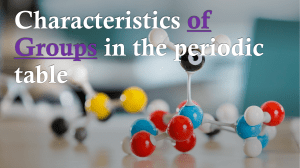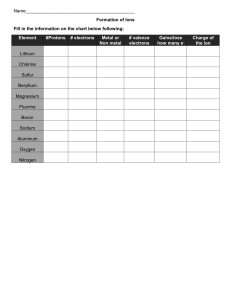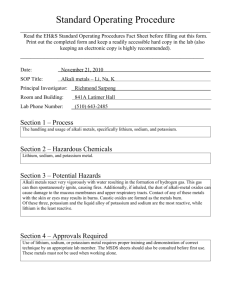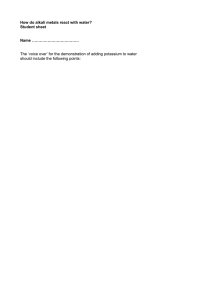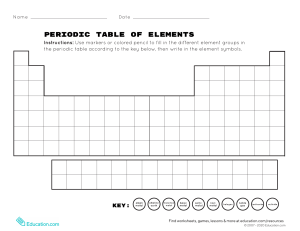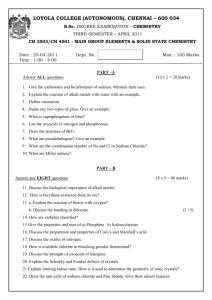SOP Demonstrating the reaction of alkali metals lithium and sodium with water 0
advertisement
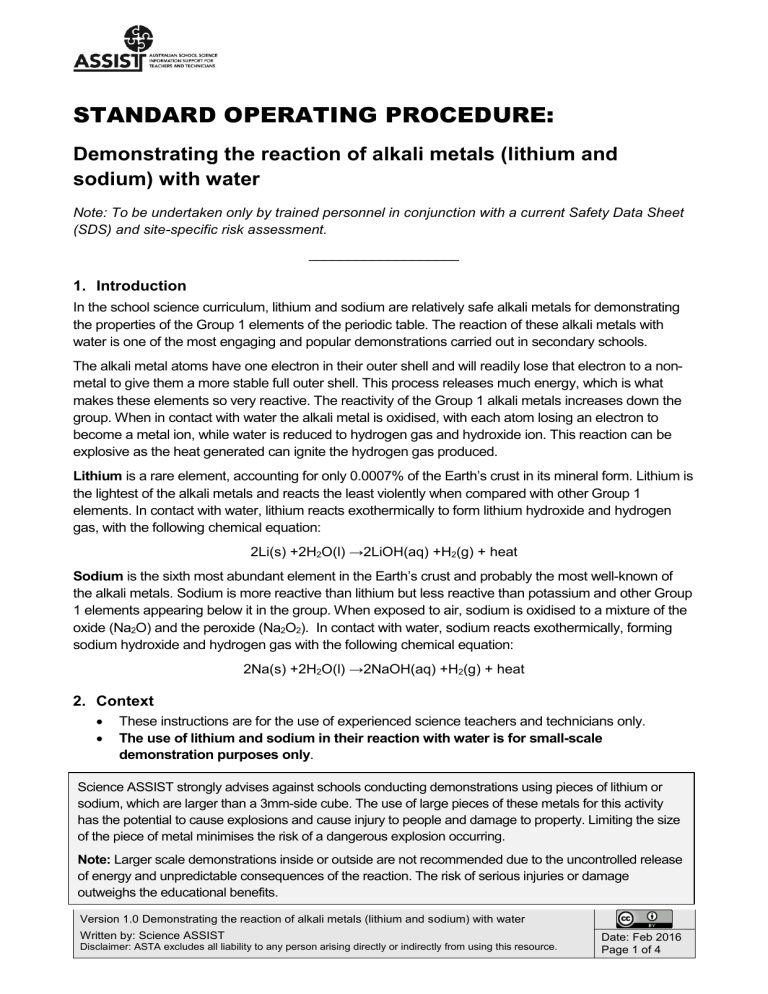
STANDARD OPERATING PROCEDURE: Demonstrating the reaction of alkali metals (lithium and sodium) with water Note: To be undertaken only by trained personnel in conjunction with a current Safety Data Sheet (SDS) and site-specific risk assessment. ___________________ 1. Introduction In the school science curriculum, lithium and sodium are relatively safe alkali metals for demonstrating the properties of the Group 1 elements of the periodic table. The reaction of these alkali metals with water is one of the most engaging and popular demonstrations carried out in secondary schools. The alkali metal atoms have one electron in their outer shell and will readily lose that electron to a nonmetal to give them a more stable full outer shell. This process releases much energy, which is what makes these elements so very reactive. The reactivity of the Group 1 alkali metals increases down the group. When in contact with water the alkali metal is oxidised, with each atom losing an electron to become a metal ion, while water is reduced to hydrogen gas and hydroxide ion. This reaction can be explosive as the heat generated can ignite the hydrogen gas produced. Lithium is a rare element, accounting for only 0.0007% of the Earth’s crust in its mineral form. Lithium is the lightest of the alkali metals and reacts the least violently when compared with other Group 1 elements. In contact with water, lithium reacts exothermically to form lithium hydroxide and hydrogen gas, with the following chemical equation: 2Li(s) +2H2O(l) →2LiOH(aq) +H2(g) + heat Sodium is the sixth most abundant element in the Earth’s crust and probably the most well-known of the alkali metals. Sodium is more reactive than lithium but less reactive than potassium and other Group 1 elements appearing below it in the group. When exposed to air, sodium is oxidised to a mixture of the oxide (Na2O) and the peroxide (Na2O2). In contact with water, sodium reacts exothermically, forming sodium hydroxide and hydrogen gas with the following chemical equation: 2Na(s) +2H2O(l) →2NaOH(aq) +H2(g) + heat 2. Context These instructions are for the use of experienced science teachers and technicians only. The use of lithium and sodium in their reaction with water is for small-scale demonstration purposes only. Science ASSIST strongly advises against schools conducting demonstrations using pieces of lithium or sodium, which are larger than a 3mm-side cube. The use of large pieces of these metals for this activity has the potential to cause explosions and cause injury to people and damage to property. Limiting the size of the piece of metal minimises the risk of a dangerous explosion occurring. Note: Larger scale demonstrations inside or outside are not recommended due to the uncontrolled release of energy and unpredictable consequences of the reaction. The risk of serious injuries or damage outweighs the educational benefits. Version 1.0 Demonstrating the reaction of alkali metals (lithium and sodium) with water Written by: Science ASSIST Disclaimer: ASTA excludes all liability to any person arising directly or indirectly from using this resource. Date: Feb 2016 Page 1 of 4 3. Safety notes Because they are so reactive with air and water, lithium and sodium require special storage conditions. They should be stored submerged under mineral oil such as paraffin oil. Lithium will float on the paraffin oil, but a film of oil over the lithium will protect it from oxidation, which is also a slower and less vigorous process than for sodium. Both lithium and sodium metals are flammable and corrosive. They can cause severe skin burns and eye damage, Minimal quantities only should be taken into the classroom for demonstrations Make sure all implements for handling these metals e.g. spatulas, forceps/tweezers, cutting surface (petri dish or ceramic tile) and scalpel/knife are clean and dry. Use a separate set of implements and cutting surface for each metal to avoid any cross contamination between them. A large volume of water should be used in the reaction vessel to reduce the risk of the reaction going out of control due to the heat generated. Both metals release hydrogen gas when reacting with water. Hydrogen is a flammable gas and it should not be allowed to accumulate in a contained volume of space or be handled near any ignition sources. The vessel should be filled with water to within 1cm from the top so there is minimal space for the air/hydrogen mixture to accumulate. Caustic fumes can also be produced and should not be inhaled. Therefore this activity should be conducted in a well-ventilated area. Pieces of the alkali metal can sometimes be ejected from the water, therefore the use of safety screens is recommended and observers should watch from a safe distance away (at least 2m). Some references suggest covering the trough with wire gauze to prevent the sodium ejecting. Never cover with a solid piece of glass or Perspex. Do not wash any unreacted pieces of metal down the sink. Ensure that all remnants of alkali metal are fully reacted at the completion of the demonstration. 4. Regulations, licences and permits Should adhere to storage and disposal requirements as described in current SDS. No licences or permits required. 5. Equipment PPE for demonstrator: lab coat, nitrile gloves and safety glasses or face shield PPE for observers: safety glasses for observers standing at least 2 metres away Container with sodium or lithium metal (submerged in paraffin oil) Spatula Tweezers or forceps Petri dish or ceramic tile to use as a cutting surface Dry paper towel (to absorb excess oil) Scalpel or sharp knife to cut the metal Reaction vessel: wide glass trough or large beaker made of quality borosilicate glass. 0.1%w/v Phenolphthalein solution in dropper bottle Perspex safety screen/s (note: (i) some references suggest the use of an operating fume cupboard; (ii) Science ASSIST recommends using a safety screen, however if the pieces of alkali metal are smaller than a 3mm-side cube, a screen may not be warranted, based upon a local risk assessment) Wire gauze to cover trough (optional) Overhead projector or a camera (optional) Version 1.0 Demonstrating the reaction of alkali metals (lithium and sodium) with water Written by: Science ASSIST Disclaimer: ASTA excludes all liability to any person arising directly or indirectly from using this resource. Date: Feb 2016 Page 2 of 4 6. Operating procedure 1. Fill a wide glass trough or large glass beaker (made of quality borosilicate glass) with water to within 1cm from the top so there is minimal space for the air/hydrogen mixture to accumulate. 2. Add a few drops of the 0.1% phenolphthalein solution into the water. The resulting solution from the reaction is basic and will be illustrated with a colour change to pink when phenolphthalein is present in water. 3. Place safety screen/s as close to the trough as possible to protect all observers and demonstrator. Ensure the correct wearing of PPE and that observers are at least 2 metres away. 4. Using a dry and clean spatula, remove one piece of the alkali metal from the storage jar. 5. Place it on the cutting surface, ensuring conditions are dry. Using a dry scalpel/sharp knife, cut a small piece of the metal, no larger than 3mm–side cube. 6. Remove excess oil from the small piece of metal by patting it on dry paper towel; oil can interfere with the reaction. Alternatively the sodium can be cut on a piece of dry paper towel in the petri dish, provided that it is not left on the paper towel for too long. 7. Whilst cutting the metal, students can be shown the shiny silver-white surface of the alkali metal which rapidly darkens due to its oxidation in air. (Sodium reacts faster with air compared to lithium). Do not pass the alkali metal around the room. 8. Return the unused metal piece to the storage container as soon as possible. Ensure metal pieces are covered in oil and that the container is securely closed. 9. Using dry forceps/tweezers, pick up the small piece of metal and carefully place it onto the water surface in the trough or beaker. A piece of wire gauze could also be used to cover the trough (optional). 10. Observe the reaction. The alkali metal should float, fizz and move leaving a pink trail behind as it reacts with the water to form its hydroxide. (The phenolphthalein indicator turns pink in the presence of the hydroxide.) Lithium will react less vigorously than sodium. Never try to constrain the metals; allow them to roam freely over the surface of the water. 11. Ensure that the forceps are dry for handling the next piece of sample of metal. 12. Use a fresh trough (or fresh water) and new dry implements for the next metal and repeat steps 1-10. 13. When the demonstration is completed, ensure that no traces of the metals remain on the tweezers/forceps, spatula, petri dish etc. The simplest way is to place them in one of the troughs of water to allow any residual metal to react. Gloved hands should also be rinsed in the water to remove any traces of metal before disposal of the gloves into the bin. Allow the metal to react completely with the water and the remaining hydroxide solution can then be flushed down the sink with plenty of water. 14. An overhead projector or a camera can be used to project the view of the reaction onto a screen. (Optional). Version 1.0 Demonstrating the reaction of alkali metals (lithium and sodium) with water Written by: Science ASSIST Disclaimer: ASTA excludes all liability to any person arising directly or indirectly from using this resource. Date: Feb 2016 Page 3 of 4 7. Trouble shooting/emergencies First Aid: See latest SDS for more detailed information If swallowed: Rinse mouth thoroughly with water immediately. Give plenty of water to drink. Give repeated drinks of water one cupful every 10 minutes. Do not induce vomiting. Rinse mouth with water, and then give water to drink. Seek urgent medical attention. If in eyes: Hold open and irrigate with copious quantity of water for at least 15 minutes. Seek medical attention. If on skin/clothes: Wash affected area thoroughly with soap and water. Remove contaminated clothing and wash before reuse or discard. Seek medical attention. For further advice contact the Poisons Information Centre on 131126 8. Waste disposal If there are any small pieces of lithium and/or sodium to be disposed, allow them to react completely with water. Do not wash them directly down the sink. The dilute hydroxide solution formed in the reaction vessel after the demonstration can be disposed of down the sink with plenty of water. 9. Related material Risk assessment for demonstrating the reaction of alkali metals (lithium and sodium) with water Current SDSs for lithium metal, sodium metal and 1% phenolphthalein solution. References: ‘Alkali metals’, Nuffield Foundation website, http://www.nuffieldfoundation.org/practical-chemistry/alkalimetals (Accessed February 2016) Carnegie Mellon University. 2010. Pyrophoric handling policy. Carnegie Mellon University website https://www.cmu.edu/ehs/chemical/pyrophorichandlingpolicy.pdf ‘Chemistry of Lithium’, UCDavis chemwiki, http://chemwiki.ucdavis.edu/Inorganic_Chemistry/Descriptive_Chemistry/Elements_Organized_by_Block/ 1_s-Block_Elements/Group__1%3A_The_Alkali_Metals/Chemistry_of_Lithium (Accessed February 2016) ‘Chemistry of Sodium, UCDavis chemwiki, http://chemwiki.ucdavis.edu/Inorganic_Chemistry/Descriptive_Chemistry/Elements_Organized_by_Block/ 1_s-Block_Elements/Group__1%3A_The_Alkali_Metals/Chemistry_of_Sodium (Accessed February 2016) CLEAPSS. 2004. Laboratory Handbook Section 13 Mainly Chemistry, CLEAPPS website http://www.cleapss.org.uk/attachments/article/0/Sec13.pdf ‘Lithium’, Sigma-Aldrich website, http://www.sigmaaldrich.com/catalog/product/aldrich/499811?lang=en&region=AU (Accessed February 2016) Organisational Health, Queensland Department of Education, Training and Employment. 2014. Unpredictable science experiments. Health and safety alert, http://education.qld.gov.au/health/pdfs/healthsafety/unpredictable-experiments.pdf ‘Phenolphthalein solution 0.5%’, Safety Data Sheet, Chem-supply, https://www.chemsupply.com.au/documents/PL1011CH7R.pdf (August 2011) ‘Sodium metal’, Safety Data Sheet, Chem-supply website, https://www.chemsupply.com.au/documents/SL0741CH6J.pdf (November 2015) Version 1.0 Demonstrating the reaction of alkali metals (lithium and sodium) with water Written by: Science ASSIST Disclaimer: ASTA excludes all liability to any person arising directly or indirectly from using this resource. Date: Feb 2016 Page 4 of 4

